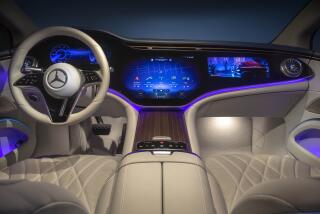Q&A: L.A. Auto Show: Vehicle infotainment systems are awful. That’s why Volvo is handing the job to Google

As the years go by, it gets harder to tell one car brand from another. Optimal aerodynamic design produces similar shapes. Engine technology is highly reliable and advanced in ways that most consumers don’t understand, or don’t care to understand. For automakers, finding ways to differentiate their products is harder and more important than ever.
One way is by improving their infotainment offerings. Anyone who has driven a late-model car can attest that the current state of infotainment systems is abysmal – confusing, distracting, poorly thought out.
Not wanting to give up control to the tech companies, most automakers patch together pieces from different vendors to design infotainment systems on their own.
Volvo, which admits its own infotainment efforts have hurt the brand’s rankings in owner-satisfaction surveys, is taking a different approach. Earlier this year, it announced a partnership with Google to become the first automaker to integrate its Android smartphone operating system into the vehicle itself – no phone necessary. The system will be incorporated into new Volvos gradually over the next three years.
The Times sat down at the Los Angeles Auto Show to talk about the system with three Volvo executives: Chief Executive Håkan Samuelsson; Henrik Green, head of research and development; and Mårten Levenstam, head of product strategy. The following transcript was edited for length and clarity.
Why is infotainment so important?
Samuelsson: Our consumer experience is what will differentiate the cars, not the chrome.
It used to be, you’d buy a new car, the neighbors would come by. You’d open the hood and look at the engine. Now they go to the car and look at the center stack. How’s the navigation? Does it have voice control? We want to bring people’s digital lives into the cars. Providing navigation with Google Maps, speech recognition … this is what consumers are interested in. It’s not the hardware and the combustion engine.
How is this different from Android Auto or Apple CarPlay, which let people make calls and play music through their cars?
Green: The car will come preloaded with Android. Google Maps, Google Assistant, Google Play Store. You don’t have to take the phone out of your pocket. It will be built in.
That includes speech recognition, right? It’s a weak spot for many carmakers. Google’s very good at it.
Green: The number of users who use speech instead of touch controls will increase a lot. As development continues and we combine speech with other functions, you can start to redesign the entire interface from scratch.
Most carmakers are trying to do this on their own. Why are you turning to Google?
Green: We came to the conclusion a while back we want cars to be part of a larger ecosystem. We saw the leaders of the tech world who would essentially own the ecosystem. We saw the enormous amount of investment and skill. As an auto manufacturer we had no chance to compete. We took the decision let’s go for it.
Why not Apple too?
Samuelsson: We’d love to work with Apple but they don’t want to. [Note: If Apple is working on a similar program with an automaker, it hasn’t been made public.]
Automakers seem reluctant to hand over control of potentially profitable data streams and customer information to tech companies.
Levenstam: We are in the business of selling cars for profit. Making our cars more effective by integrating Google services will make the cars more attractive and we will sell more cars, and that’s the revenue stream.







